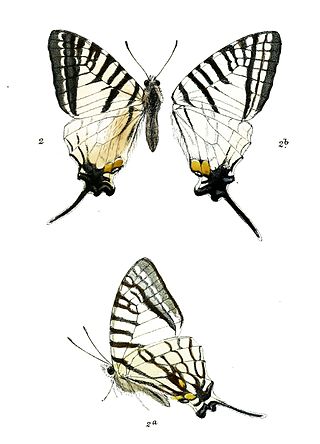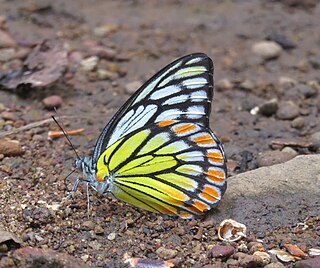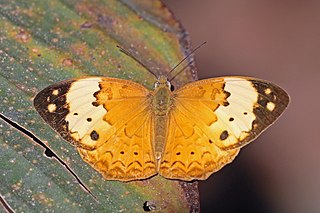
Acraea terpsicore, the tawny coster, is a small, 53–64 millimetres (2.1–2.5 in), leathery-winged butterfly common in grassland and scrub habitats. It belongs to the Nymphalidae or brush-footed butterfly family. It has a weak fluttery flight. It is avoided by most insect predators. This species and the yellow coster are the only two Indian representatives of the predominantly African tribe Acraeini. It is found in India, Sri Lanka, Maldives to Myanmar, Thailand, Laos, Cambodia, Vietnam, Bangladesh, Singapore, and recently Australia

Phalanta phalantha, the common leopard or spotted rustic, is a sun-loving butterfly of the nymphalid or brush-footed butterfly family.

Tirumala limniace, the blue tiger, is a butterfly found in South Asia, and Southeast Asia that belongs to the brush-footed butterfly family, Nymphalidae. More specifically it is part of the crows and tigers or danaid group. This butterfly shows gregarious migratory behaviour in southern India. In some places, it may be found in congregations with Danaus genutia, Tirumala septentrionis, Euploea sylvester, Euploea core, Parantica aglea, and at high elevations, with Parantica nilgiriensis, on Crotalaria.

Graphium agamemnon, the tailed jay, is a predominantly green and black tropical butterfly that belongs to the swallowtail family. The butterfly is also called the green-spotted triangle, tailed green jay, or green triangle. It is a common, non-threatened species native to Nepal, India, Sri Lanka through Southeast Asia and Australia. Several geographic races are recognized. The species was first described by Carl Linnaeus in his 1758 10th edition of Systema Naturae.

Graphium sarpedon, the common bluebottle or blue triangle in Australia, is a species of swallowtail butterfly that is found in South and Southeast Asia, as well as eastern Australia. There are approximately sixteen subspecies with differing geographical distributions.

Graphium nomius, the spot swordtail, is a butterfly found in South and Southeast Asia that belongs to the swallowtail family. The species was first described by Eugenius Johann Christoph Esper in 1793. One of the grandest sights is a host of spot swordtails mud-puddling or swarming around a flowering forest tree.

Belenois aurota, the pioneer or pioneer white or caper white, is a small to medium-sized butterfly of the family Pieridae, that is, the yellows and whites, which is found in South Asia and Africa. In Africa, it is also known as the brown-veined white, and is well known during summer and autumn when large numbers migrate north-east over the interior.

Graphium doson, the common jay, is a black, tropical papilionid (swallowtail) butterfly with pale blue semi-transparent central wing bands that are formed by large spots. There is a marginal series of smaller spots. The underside of wings is brown with markings similar to upperside but whitish in colour. The sexes look alike. The species was first described by father and son entomologists Cajetan and Rudolf Felder.

Papilio polymnestor, the blue Mormon, is a large swallowtail butterfly found in south India and Sri Lanka. It is the "state butterfly" of the Indian state of Maharashtra. With a wingspan of 120–150 mm, it is the fourth largest butterfly of India.

Papilio clytia, the common mime, is a swallowtail butterfly found in south and southeast Asia. The butterfly belongs to the subgenus Chilasa, the black-bodied swallowtails. It serves as an excellent example of a Batesian mimic among the Indian butterflies.

Graphium eurous, the sixbar swordtail, is a swallowtail butterfly belonging to the genus Graphium, also known as the swordtails.

Graphium eurypylus, the great jay or pale green triangle, is a species of tropical butterfly belonging to the family Papilionidae.

Graphium cloanthus, the glassy bluebottle, is a common, non-threatened tropical butterfly of the family Papilionidae.

Prioneris sita, the painted sawtooth, is a small butterfly of the family Pieridae, that is, the yellows and whites, which is found in south India and Sri Lanka.

Libythea myrrha, the club beak, is a butterfly found in India that belongs to the Libytheinae group of the brush-footed butterflies family found in the Indomalayan realm.

Charaxes bernardus, the tawny rajah, is a butterfly that belongs to the rajahs and nawabs group, that is, the Charaxinae group of the brush-footed butterflies family. This species can be found in India, China, Indomalaya, and onwards to Indonesia.

Cupha erymanthis, the rustic, is a species of brush-footed butterfly found in forested areas of tropical South Asia and Southeast Asia. The males and females are identical.

Graphium colonna, the black swordtail or mamba swordtail, is a species of butterfly in the family Papilionidae (swallowtails). It is found in Africa.

Graphium polistratus, the dancing swordtail, is a butterfly in the family Papilionidae (swallowtails). It is found in Nigeria, the Democratic Republic of the Congo, the coast of Kenya, Tanzania, northern Malawi and Mozambique. Its habitat consists of warm and coastal forests.





















